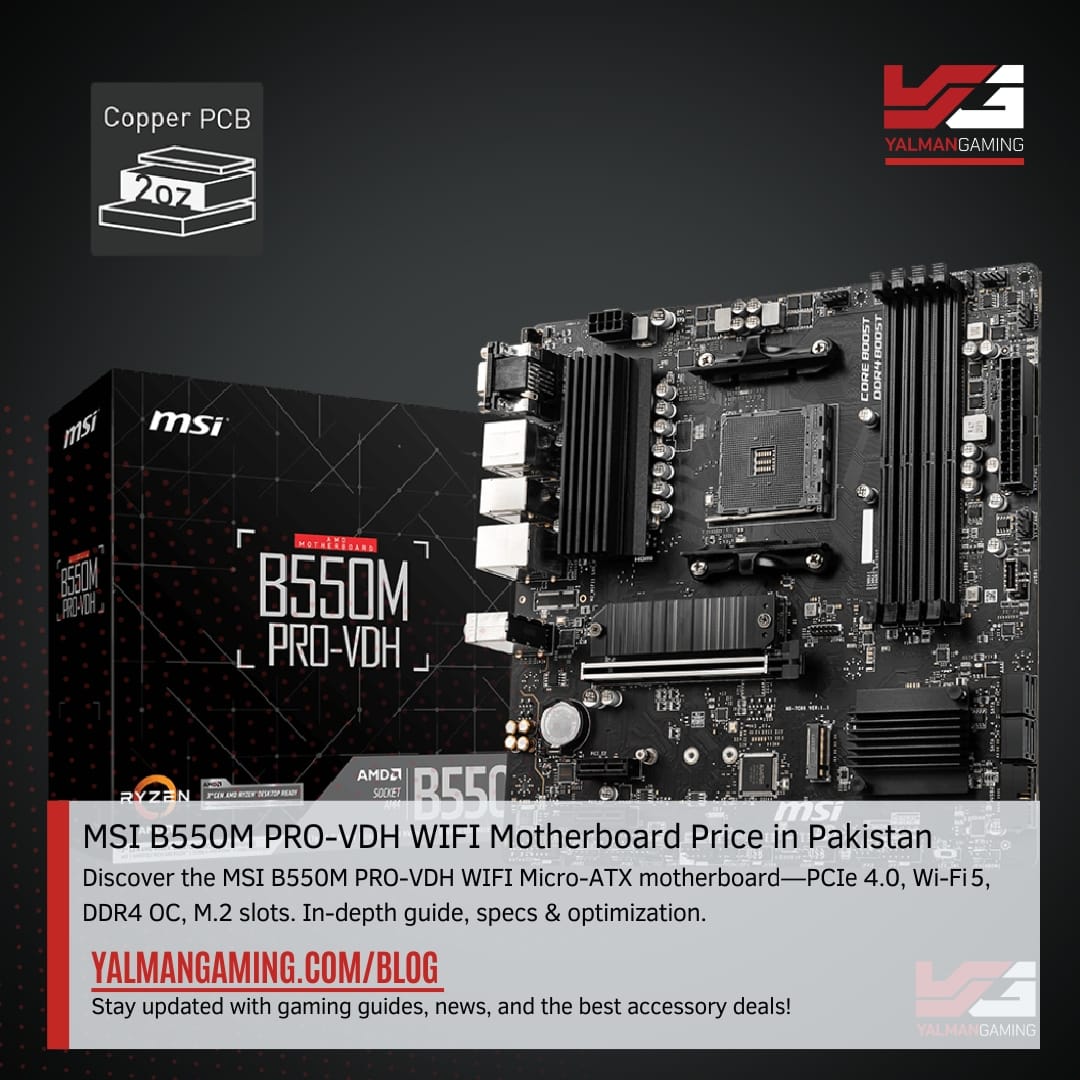Blog
MSI B550M PRO-VDH Motherboard Price in Pakistan

MSI B550M PRO-VDH Motherboard Price in Pakistan: Ultimate Deep Dive
We present a thorough examination of the MSI B550M PRO‑VDH, crafted to guide PC builders, gamers, and professionals to make informed decisions. This article spans performance, design, connectivity, BIOS, real-world testing, and comparison—all in an authoritative, structured format.

1. Overview & Product Positioning
We begin by positioning the MSI B550M PRO‑VDH within the Micro‑ATX AM4 landscape. Released mid‑2020 and updated with BIOS to support Ryzen 5000 and future AM4 CPUs, this board merges modern performance with budget consciousness.
It targets users who require PCIe 4.0 support, ample DDR4 overclocking headroom, built‑in Wi‑Fi and Bluetooth, and reliable power delivery in a compact form factor—all without premium flagship pricing.
Key selling points:
- AM4 socket with Ryzen 3000/5000 Gen support (after BIOS update)
- PCIe 4.0 x16 slot (CPU‑direct), Lightning Gen4 x4 M.2
- Dual‑band Wi‑Fi 5 (Intel 3168) & Bluetooth 4.2 up to 433 Mbps
- Micro‑ATX size (9.6″×9.6″) — ideal for compact setups
While not premium-tier, we see this board delivering excellent value for everyday builds, professional workflows, and budget-conscious gaming.
2. Form Factor & Build Quality
The B550M PRO‑VDH adopts a 24.4 × 24.4 cm Micro‑ATX PCB sporting an all‑black aesthetic, free from flamboyant RGB—although RGB headers are included if desired .

Power Delivery & VRM Design
The board incorporates a 2‑oz thickened copper layer to enhance thermal stability and signal integrity. Its precision-drilled mounting holes and robust PCB construction meet OEM standards.
It includes:
- ESD protection layers, especially around I/O, PCIe and DIMM slots.
- Steel Armor reinforced PCIe x16 slot with XL retention clip for GPU durability and anti-bend reinforcement.
These build details suggest MSI’s focus on long-term durability and everyday reliability.
3. Power Delivery & VRM Design
Efficient power delivery is central to stability and performance. This board features a 4+2+1 phase design:
- 4 VCore phases: high‑side On Semiconductor 46A 4C029N, low‑side 78A 4C024N
- 2 SOC phases, 1 memory phase, controlled via digital PWM and Core Boost tech .
MSI heatsinks the VCore MOSFET bank with screwed heatsinks, notable in this price segment . No direct SOC heatsink exists—standard for mid-tier boards.
Tom’s Hardware confirms it handled a Ryzen 9 3900X at stock and overclocked without throttling . Reddit and Linus Tech Tips community note that this VRM matches the B450 Tomahawk Max in quality. Overall, it ensures dependable operation even under demanding loads.
4. Memory Support & Overclocking
With four DIMM slots supporting up to 128 GB DDR4, this board targets serious multitaskers and professionals .
It supports OC speeds up to DDR4 4400+ MHz (one DIMM per channel), with two DIMMs per channel rated to at least 3866MHz . Tom’s Hardware managed stable 3600 MHz on a 4‑stick 32 GB kit .
MSI’s BIOS includes a Memory Try It feature offering ~30 one-click overclocking profiles, making memory tuning very accessible. Reddit builds confirm Ryzen 5000 compatibility & stable XMP performance post-BIOS update .
We recommend quality B‑die RAM, pair with Ryzen 5/7 CPUs to maximize performance without needing high-end B550E/X boards.
5. Storage & Expansion Options
The storage configuration is rich for a budget Micro‑ATX board:
- Dual M.2 slots:
- Top M.2 (CPU lanes) supports PCIe 4.0 x4 and SATA, includes M.2 Shield Frozr heatspreader .
- Secondary M.2 (chipset) supports PCIe 3.0 x4 only, no heatsink
- 4× SATA 6 Gb/s ports, supporting RAID 0/1/10; M.2 also supports RAID 0/1 NVMe .
- 1× PCIe 4.0 x16 slot for GPU, plus 2× PCIe 3.0 x1 slots for expansion.

Storage & Expansion Options
MSI’s M.2 Shield Frozr helps prevent thermal throttling on PCIe 4.0 NVMe drives .
This layout is ideal for high-speed storage setups, RAID configurations, and remains expandable for future upgrades.
6. Graphics Output & PCIe Configuration
For users with APUs or no discrete GPU, rear video includes:
- HDMI 2.1 (up to 4K@60 Hz),
- DisplayPort (4K@60 Hz),
- VGA (legacy 2048×1536@50 Hz) .
Single PCIe 4.0 x16 GPU slot offers full bandwidth for Ryzen 3000+/5000 CPUs. Slot reinforcement ensures rigidity.
While multi‑GPU isn’t supported, two PCIe 3.0 x1 slots accommodate USB cards, sound cards, or network adapters.
7. Networking: LAN, Wi‑Fi 5 & Bluetooth
Connectivity includes:
- Realtek 8111HN Gigabit LAN – stable and widely supported .
- Intel Wireless‑AC 3168 for Wi-Fi 5 dual-band up to 433 Mbps with included antennas .
- Bluetooth 4.2 supporting BLE, aptX not stated.
- BIOS Flashback allows updating BIOS via USB without CPU/DDR/GPU mounted .
These features combine to make it a solid option for wireless-enabled compact builds.
8. Audio Performance & Codec Analysis
Onboard audio includes:
- Realtek ALC892/897 codec with support for 7.1‑channel audio .
- Four Chemicon audio capacitors, ground‑layer separation .
- Tom’s Hardware notes the audio is “mid‑range”—adequate for general use, not for audiophile setups.
For higher fidelity, users can install a dedicated sound card via PCIe slot.
9. Cooling Features & Thermal Management
Key cooling elements:
- Screwed-on VRM heatsinks on VCore bank only .
- Five 4‑pin fan/pump headers, including dedicated pump header at 3 A.
- EZ Debug LEDs for CPU, DRAM, VGA, and boot phase troubleshooting.
- M.2 Shield Frozr pad with 7 W/mK thermal performance .

Cooling Features & Thermal Management
MSI’s BIOS/Dragon Center allows fan profiles based on temperature targets .
These features ensure stable temperatures across components even under sustained workloads.
10. Rear I/O & Peripheral Connectivity
Rear connectors include:
- USB: 4× USB 3.2 Gen 1 Type‑A, 2× USB 2.0 .
- Display outputs detailed in section 6.
- Gigabit LAN jack, Wi‑Fi antenna ports, BIOS Flashback button .
- 3‑port analog audio stack and PS/2 combo port .
Internally, it offers front USB‑C header, multiple USB‑3.2/2.0 headers, RGB/ARGB headers, TPM and chassis intrusion connectors .
This configuration suits both current needs and future expansion.
11. BIOS & Utility Software Ecosystem
The board features MSI Click BIOS 5, offering both EZ and Advanced modes. Highlighted features:
- OC section front-loaded for easy tuning.
- EZ debug LED indicators integrated into BIOS.
- Memory Try It profiles .
- Recovery options and BIOS Flashback.
Software includes:
- Dragon Center for monitoring, fan control, and Mystic Light RGB.
- MSI‑skinned CPU‑Z, Realtek Audio Console .
While lacking advanced AI or overclocking wizards, core utilities cover main use cases effectively.
12. Real‑World Use & User Feedback
Tom’s Hardware testing validated overclocked Ryzen 9 3900X without VRM throttling. Build includes premium cooling and memory at 3600 MHz .
Reddit reports:
“My issues was because of the combination of this board + my Ryzen 7 5700G … The only solution … downgrade PCIE version from 3.0 to 2.0”
Linus Tech Tips says:
“Nope, perfectly good budget board … better than the pro 4.”
Real‑World Use & User Feedback
Amazon comments highlight ease-of-use, abundant headers, but note occasional reboot issues, often BIOS-related .
PCPartPicker users praise plug‑and‑play Wi‑Fi and simple installation .
In summary, reports suggest occasional USB/PSU restart issues with certain APU combinations—resolved in BIOS—otherwise reliable and user‑friendly.
13. Comparison with Peer Micro‑ATX B550 Boards
We compare with ASUS Prime B550M‑K and ASRock B550M‑HDV:
MSI B550M PRO-VDH Motherboard Price in Pakistan
| Feature | MSI B550M PRO‑VDH | ASUS Prime B550M‑K | ASRock B550M‑HDV |
|---|---|---|---|
| VRM | 4+2+1 Phases, heatsink | 6+2, no heatsink | 4+3, no heatsink |
| M.2 slots | 2 (CPU PCIe4 + chipset) | 2 (chipset) | 1 |
| Wi‑Fi/Bluetooth | Yes, Intel 3168 | No | No |
| Memory OC | DDR4‑4400+ | DDR4‑4400+ | DDR4‑4400+ |
| BIOS Flashback | Yes | No | No |
| Price | ~$110–140 | ~$100–120 | ~$90–110 |
MSI stands out—cheaper than ASUS, offers Wi‑Fi, flashback, heatsinks. Asrock is cheapest but minimal features.
14. Pros & Cons Summary
✅ Pros
- Affordable pricing (~$110–140)
- Ryzen 5000 & future support via BIOS
- PCIe 4.0 GPU + PCIe 4.0 M.2 with heatsink
- Dual M.2, SATA RAID support
- Built‑in Wi‑Fi 5 & BT 4.2
- BIOS Flashback for CPU‑less updates
- Memory Try It OC profiles
- Solid VRM comparable to Tomahawk Max
❌ Cons
- Some users report USB restart issues with Ryzen APUs; a BIOS workaround is needed
- SOC VRM lacks a dedicated heatsink
- Audio codec is mid‑range (ALC892/897)
- Only one rear USB‑C header

MSI B550M PRO-VDH Motherboard
15. Final Verdict
We conclude that the MSI B550M PRO-VDH Motherboard Price in Pakistan delivers outstanding value in the budget Micro‑ATX AM4 space. Its combination of PCIe 4.0 support, dual M.2 slots, built‑in Wi‑Fi 5, robust VRM, flashback BIOS, and memory OC features exceeds expectations for its price class. Despite minor quirks under specific CPU/APU combos, its strengths overwhelmingly favor reliable long-term usage.
For gamers, content creators, or professionals building compact yet powerful systems, this board presents a compelling core platform. Its savings allow investment in higher‑end GPUs, RAM, or storage without compromising foundational quality.
16. FAQs
1. Does the B550M PRO support Ryzen 5000 CPUs out of the box?
After a BIOS update using Flashback, yes—it supports Ryzen 5000 and future AM4 processors reliably.
2. Can I run PCIe 4.0 NVMe SSDs on this board?
Yes—the top M.2 slot supports PCIe 4.0 x4 with an M.2 Shield Frozr heatsink; the bottom slot supports PCIe 3.0 only.
3. Are there issues with Ryzen 7 5700G and USB stability?
Some users reported USB/power issues with Ryzen 5700G; a BIOS update or PCIe speed adjustment resolved it .
4. Does it have Bluetooth support?
Yes—it includes Bluetooth 4.2 alongside dual‑band Wi‑Fi 5 via Intel 3168.
5. Is BIOS Flashback really available?
Yes—users praise this as “lifesaving”—for updating BIOS without CPU or memory installed.
Product Specifications
| Chipset | AMD B550 |
|---|---|
| CPU Socket | AM4 (Ryzen 3000/5000; future BIOS‑update support) :contentReference[oaicite:2]{index=2} |
| Memory Support | 4× DDR4 DIMM, up to 128 GB; JEDEC 1866–3200 MT/s; OC up to 4400+ MT/s |
| Expansion Slots | 1× PCIe 4.0×16; 2× PCIe 3.0× |
| Storage Interface | 2× M.2 slots (1× PCIe 4.0/3.0, 1× PCIe 3.0); 4× SATA 6 Gb/s |
| Graphics Interface | 1× HDMI 2.1; 1× DisplayPort 1.2; 1× VGA (requires iGPU) |
| USB Ports | Rear: 4× USB 3.2 Gen 1; 2× USB 2.0 Internal: 1× USB‑C header; 1× USB 3.2 Gen 1 header; 2× USB 2.0 |
| LAN | Realtek RTL8111HN 1 Gbps Ethernet |
| Audio | Realtek ALC892/897 7.1‑Channel HD Audio |
| Wireless & Bluetooth | None (Wi‑Fi only on PRO‑VDH WIFI version) |
| Form Factor | Micro‑ATX (244×244 mm) |


